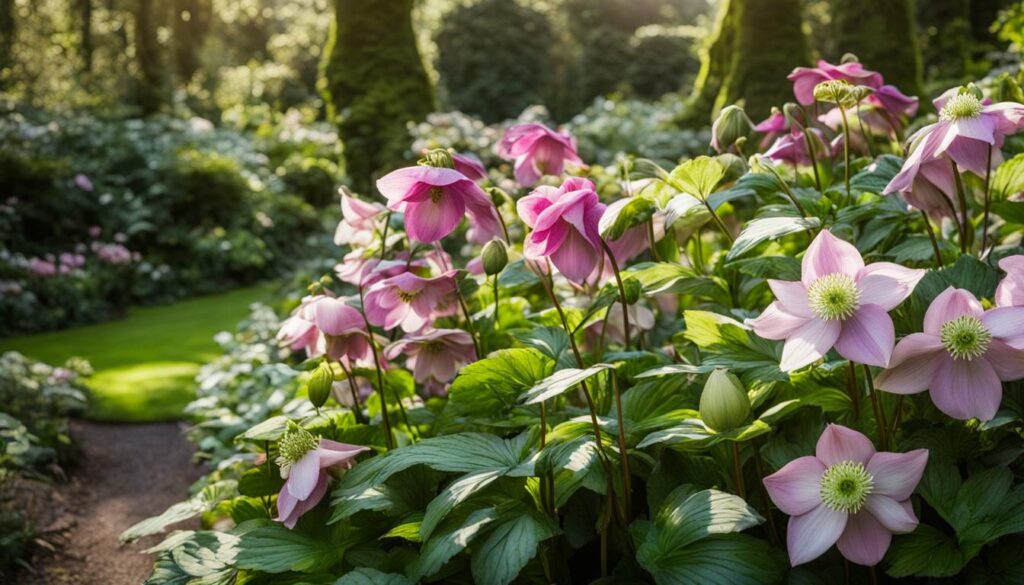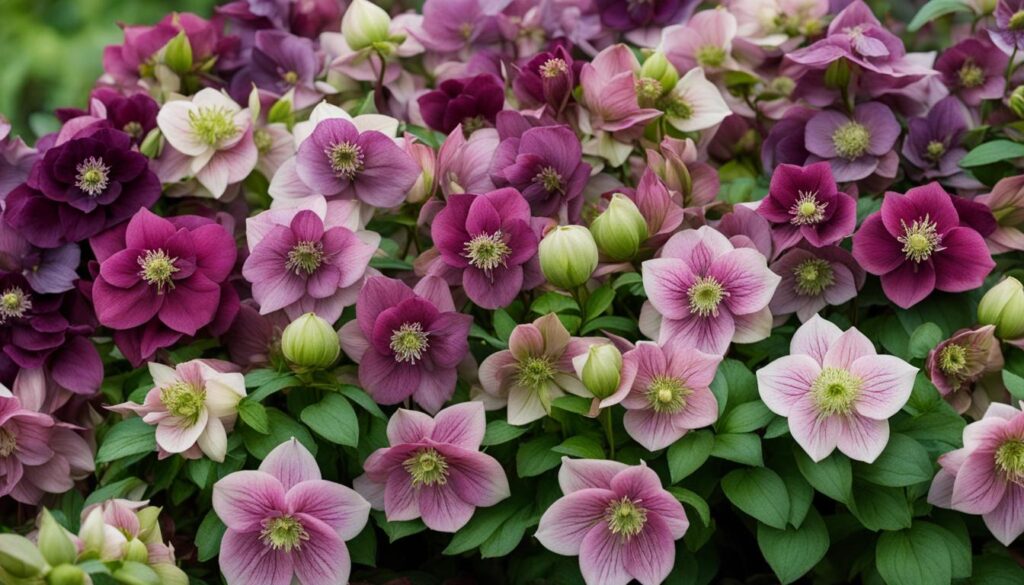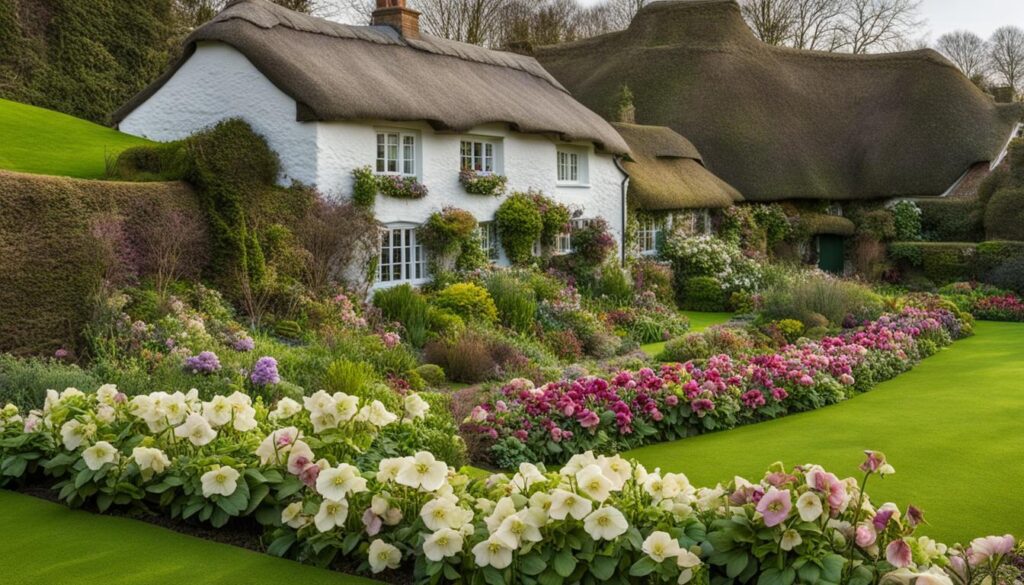
How To Grow Hellebores In The UK
Hellebores, known for their stunning winter blooms, are a popular choice for British gardens. If you’re looking to add these beautiful perennials to your outdoor space, we’ve got you covered with expert cultivation tips and advice for caring for hellebores in the UK.
Key Takeaways:
- Choose hellebore varieties that thrive in the UK climate and your specific growing conditions.
- Plant hellebores in light or dappled shade with enriched soil.
- Provide adequate water and mulch the soil around hellebores to retain moisture.
- Consider overwintering and protection for less hardy hellebore varieties.
- Propagate hellebores through seed collection or purchase healthy plants from reputable sources.
Choosing the Right Hellebores for Your Garden
When it comes to selecting hellebores for your garden, it’s important to consider their preferred growing conditions in the UK. Opting for hellebore varieties that flourish in your climate ensures successful growth and vibrant blooms. Here are some hellebore options to consider:
Easy-to-Grow Hellebores
The easy-to-grow hellebores, such as the Oriental hybrids (Helleborus x hybridus), are an excellent choice for UK gardens. These hardy and long-lived varieties produce nodding flowers in a stunning array of colors, including white, pink, ruby, and dark plum. Oriental hybrids are perfect for adding a touch of elegance to your outdoor space.
Other easy-to-grow hellebores that thrive in the UK climate include:
- Holly-leaved hellebore (H. argutifolius)
- Hybrid H. x ericsmithii
- Stinking hellebore (H. foetidus)
- Variable hybrid H. x nigercors
These hellebores prefer partial sun exposure and are known for their durability. However, keep in mind that they tend to be short-lived.
Hellebores Requiring More Care
For gardeners seeking a challenge or looking to diversify their hellebore collection, there are varieties that require a little extra attention. These include:
- Helleborus niger, which requires excellent drainage
- Helleborus lividus and Helleborus thibetanus, ideally grown in containers or a cool, sheltered spot
These hellebores demand specific growing conditions and may need additional care, but their unique characteristics make them worthwhile additions to your garden.
Remember, when choosing hellebores, it’s crucial to consider the specific growing conditions of each variety to ensure successful growth in the UK climate.

| Hellebore Variety | Growing Conditions |
|---|---|
| Oriental hybrids (Helleborus x hybridus) | Partial sun, well-drained soil |
| Holly-leaved hellebore (H. argutifolius) | Pure sun, sheltered from cold winds |
| Hybrid H. x ericsmithii | Partial sun, well-drained soil |
| Stinking hellebore (H. foetidus) | Partial sun, well-drained soil, deeper shade |
| Variable hybrid H. x nigercors | Partial sun, well-drained soil |
| Helleborus niger | Excellent drainage, dappled shade |
| Helleborus lividus, Helleborus thibetanus | Containers or a cool, sheltered spot |
Planting and Caring for Hellebores in the UK
To ensure successful Hellebore growth in the UK, it’s essential to follow proper planting and maintenance practices. Here are some valuable tips for nurturing your Hellebores in British gardens:
1. Choose the Right Location
Hellebores thrive in light or dappled shade, making them ideal for woodland gardens. However, some varieties can tolerate sun or deeper shade. When selecting a location, consider the specific sunlight requirements of the Hellebore variety you’re planting. For example, H. foetidus prefers deeper shade, while H. argutifolius and H. x sternii thrive in sun, sheltered from cold winds.
2. Prepare the Soil
Enrich the soil with organic matter, such as well-rotted compost, before planting your Hellebores. They prefer soil that is neither too dry nor waterlogged. Ensure good drainage to prevent waterlogging. If you’re planting Hellebores in containers, use a free-draining compost. Regularly water container-grown Hellebores to keep the soil moist.
3. Watering and Feeding
Established Hellebores generally don’t require much watering, but they benefit from occasional watering during hot, dry spells. Avoid overwatering, as Hellebores dislike waterlogged conditions. They seldom need additional feeding, but if growth is poor, a general-purpose fertilizer can be applied according to the manufacturer’s instructions.
4. Mulch for Moisture Retention
Mulching the soil around your Hellebores annually helps retain moisture and suppress weed growth. Apply a layer of organic mulch, such as wood chips or leaf compost, around the base of the plants. This will also provide additional nutrients as the mulch decomposes over time.
5. Overwintering and Protection
The hardiness of Hellebores varies among different species and cultivars. Some varieties can withstand harsh winter conditions, while others may require protection. If you have less hardy Hellebores, consider providing winter protection by covering them with horticultural fleece or relocating potted specimens to a cool greenhouse or a sheltered spot.
By following these UK specific Hellebore growing advice, you can ensure the successful growth and maintenance of Hellebores in your British garden. With their beautiful blooms during the winter and early spring, Hellebores are a valuable addition to any outdoor space.
Propagating and Buying Hellebores for UK Gardens
If you want to expand your collection of hellebores or start cultivating them in your UK garden, there are two main options: propagating them through seed collection or buying hellebores from reputable sources. Let’s explore both methods to help you make an informed decision.
Propagating Hellebores through Seed Collection
Propagating hellebores from seeds can be an exciting and rewarding process. However, it’s important to note that the resulting seedlings may not be true to their parent plant in terms of color or other characteristics. If you’re open to the element of surprise and enjoy experimenting with different variations, seed propagation is a great option.
To collect hellebore seeds, wait until the seed pods have ripened and turned brownish-black in color. Gently crush the pods and release the seeds into a container. Remove any debris and dry the seeds for a few days before storing them in a cool, dry place.
To sow the seeds, fill a tray or pot with a well-draining seed compost. Sow the seeds on the surface and cover them lightly with a thin layer of vermiculite. Water the seeds gently and cover the tray or pot with a clear plastic bag or lid to create a greenhouse-like environment. Place it in a bright, cool spot out of direct sunlight.
It may take several weeks or even months for the seeds to germinate. Once they have sprouted, remove the cover and provide them with sufficient light. Transplant the seedlings into individual pots when they have developed their first true leaves. Continue to care for them until they are ready to be planted in your garden.
Buying Hellebores from Garden Centres or Online Suppliers
If you prefer more immediate results or specific hellebore varieties, buying established plants is the way to go. In the UK, garden centres and online suppliers offer a wide selection of hellebores, especially during the winter and spring when they are in flower.
When purchasing hellebores, it’s essential to choose healthy plants and ensure they are free from any signs of damage or disease. Look for vibrant foliage, strong stems, and well-developed roots. Avoid plants with yellowing leaves, wilting stems, or any obvious signs of pests or diseases.
Hellebores are typically sold in pots, with younger plants offering great potential for growth and more mature plants providing an immediate visual impact. Consider the specific hellebore varieties that are suitable for the UK climate and your garden’s growing conditions. Choose the ones that match your preferences in terms of flower colors, forms, and growth habits.
Buying and Propagating Hellebores: a Comparison
| Method | Advantages | Disadvantages |
|---|---|---|
| Propagating from Seeds |
|
|
| Buying Established Plants |
|
|
Whether you choose to propagate hellebores from seeds or buy established plants, both methods have their advantages and considerations. Seed propagation offers excitement and variation, while buying plants provides immediate results and the assurance of specific characteristics. Consider your goals, preferences, and resources to determine the best approach for your hellebore collection.

Next, in our final section, we will summarize the key points and provide some concluding thoughts on cultivating hellebores in the UK.
Conclusion
Growing hellebores in the UK can be a rewarding experience. These hardy perennials provide beautiful blooms during the winter and early spring, adding a touch of vibrant color to your garden. To cultivate hellebores successfully, it’s crucial to choose the right varieties that thrive in the UK climate.
By considering the specific growing conditions of each hellebore variety, you can create an optimal environment for their growth. Whether you’re starting from seeds or buying established plants, it’s important to ensure they come from reputable sources.
With proper care and maintenance, hellebores can flourish in British gardens. Provide them with dappled shade, enriched soil, and adequate moisture. Remember, some varieties may require extra protection during colder months. By following these UK-specific hellebore growing advice, you can enjoy the beauty of hellebores in your outdoor space year after year.
FAQ
How do I grow hellebores in the UK?
Hellebores are perennials that thrive in the UK climate. They prefer light or dappled shade and well-draining soil enriched with organic matter. Plant them in autumn to spring and provide regular watering and mulching.
What are the best hellebore varieties for the UK?
The most popular hellebores in the UK are the Oriental hybrids (Helleborus x hybridus), which come in a variety of colors and speckled patterns. Other suitable varieties include the stinking hellebore (H. foetidus) and the holly-leaved hellebore (H. argutifolius).
How should I care for hellebores in the UK?
Hellebores require minimal maintenance but benefit from regular watering during hot, dry spells. They seldom require feeding, but if growth is poor, a general-purpose fertiliser can be applied. Mulching the soil annually helps retain moisture. Some hellebores may need protection in a cool greenhouse or sheltered spot during winter.
Can I propagate hellebores in the UK?
Yes, hellebores can be propagated through seed collection, although the seedlings may not be true to their parent plant. You can also buy hellebores from garden centers or online suppliers in the UK. Look for healthy plants and check for signs of damage or disease before purchasing.
Why should I grow hellebores in the UK?
Growing hellebores in the UK can be a rewarding experience, as these hardy perennials provide beautiful blooms during the winter and early spring. By choosing the right hellebore varieties for your garden, providing the necessary care and maintenance, and propagating or buying them from reputable sources, you can enjoy vibrant and healthy hellebores in your UK garden.